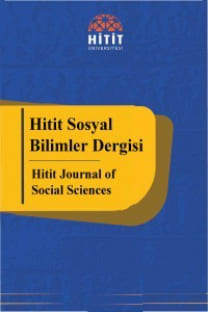RELATION BETWEEN LEARNING STYLES, METHODS FOR OBTAINING INFORMATION AND ACADEMIC ACHIEVEMENTS OF TURKISH UNIVERSITY STUDENTS
Üniversite Öğrencileri, VARK Öğrenme Stilleri, Akademik Başarı
-
University Students, VARK Learning Styles, Academic Achievement,
___
- ALKHASAWEH, I.M., Mrayyan, M.T., Docherty, C., Alashram, S., Yosef, H. (2008). Problem-Based Learning (PBL): Assessing Students’ Learning Preferences Using VARK. Nurse Education Today, 28, 572-579.
- ARSAL, Z.,& Ozen, R. (2007). Examining the Learning Strategies and Learning Style Preferences of Candidate Classroom Teachers. Journal of Abant Izzet Baysal University Faculty of Education, 7 (2), 151-164.
- BAYKAN, Z., & Nacar M. (2007). Learning Styles of First-Year Medical Students Attending Erciyes University in Kayseri, Turkey. Adv Physiol Educ, 31, 158–160.
- COLLINS, J. (2004). Education Techniques for Lifelong Learning: Principles of Adult Learning. Radiographics, 24(5), 1483-1489.
- CORTRIGHT, R.N., Collins, H.L., DiCarlo, S.E. (2005). Peer Instruction Enhanced Meaningful Learning: Ability to Solve Novel Problems. Adv Physiol Educ, 29, 107– 111.
- FLEMING, N. (2007), VARK: A Guide to Learning Styles (online), (erişim adresi: http:// www.vark-learn.com/english/page.Asp? p=questionnaire), (erişim tarihi: 12 March 2014].
- FLEMING, N.D., & Mills, C. (1992). Not Another Inventory, Rather a Catalyst for Reflection. To Improve Acad, 11, 137-155.
- JOHNSON, M. (2009). Evaluation of Learning Style for First Year Medical Students. International Journal for the Scholarship of Teaching and Learning, 3(1),1-5.
- KHARB, P., Samanta, P.P., Jindal, M., Singh, V. (2013). The Learning Styles and the Preferred Teaching–learning Strategies of First Year Medical Students. Journal of Clinical and Diagnostic Research, 7(6), 1089-1092.
- LUJAN, L.H., & Dicarlo, S.E. (2006). Too Much Teaching, Not Enough Learning: What Is The Solution? Adv Physiol Educ, 30, 17–22.
- NUZHAT, A., Salem, R.O., Mohammed, S.A., Nasir, A.H. (2011). Learning Style Preferences of Medical Students: A Single-Institute Experience From Saudi Arabia. Int J Med Edu, 2, 70-73.
- OKUR, M., Bahar, H.H., Akgun, L., Bekdemir, M. (2011). Department of Mathematics Students’ Learning Styles, States of Trait Anxiety and Academic Success. Journal of Turkey Social Research, 15 (3), 123-134.
- SHAH, C., Joshi, N., Mehta, H.B., Gokhle, P.A. (2011). Learning Styles Adopted ByMedical Students. IJRP, 227-229.
- TUYSUZ, C., & Tatar, E. (2008). Effect of the Pre-service Teachers’ Learning Styles on Chemistry Achievement and Attitudes. Journal of Mustafa Kemal University Social Science Institution, 5(9), 97-101.
- Yayın Aralığı: Yılda 2 Sayı
- Başlangıç: 2008
- Yayıncı: Hitit Üniversitesi
OSMAN ÇEVİKSOY’UN HİKÂYELERİNDE ALMANYA’DAKİ BİRİNCİ VE İKİNCİ KUŞAK GÖÇMEN TÜRKLER
SPORDA TOPARLANMA STRATEJİLERİ
Hayrettin GÜMÜŞDAĞ, Halit EGESOY, Emrah CERİT
ANTİK DÖNEMDE ORBİTAL SELÜLİT: CİDE/TÜRBETEPE TÜMÜLÜSÜ’NDEN BİR ÖRNEK
POLİSLİĞİN KRONİK HASTALIĞI: KİNİZM
Gülay YILMAZEL, Nuriye BÜYÜKKAYACI DUMAN, Ayşe BAŞÇI
TÜRKİYE’DE ÇOCUK YOKSULLUĞU: GAZİANTEP ÜZERİNE BİR ARAŞTIRMA
Fatih KAHRAMAN, Songül SALLAN GÜL, Songül SALLAN GÜL
GELİR VERGİSİ KANUNU ÇERÇEVESİNDE DEĞER ARTIŞ KAZANCI VERGİLEMESİ
Betül ALTAY TOPCU, Sevgi SÜMERLİ SARIGÜL
